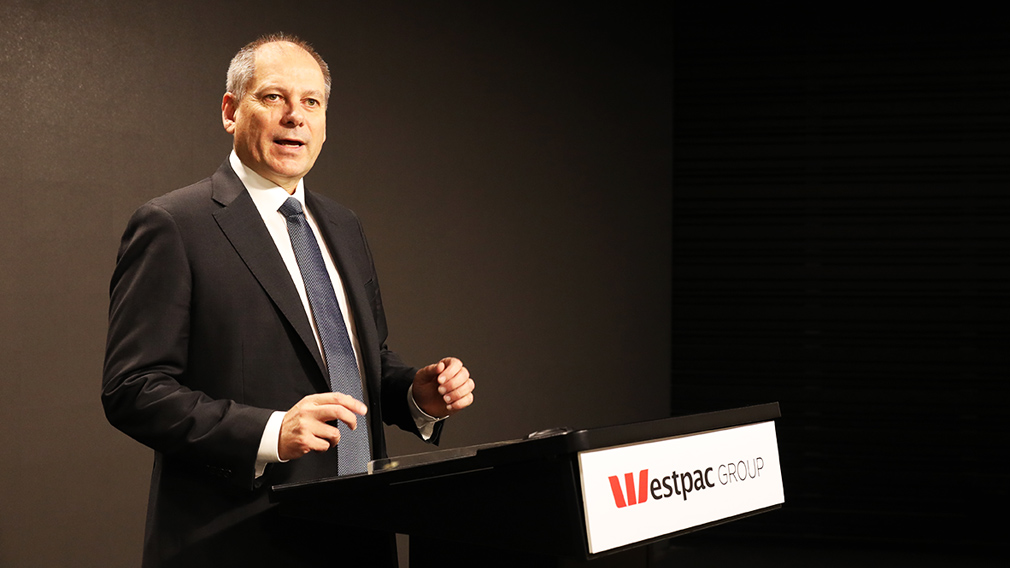King: Buyback and strategic progress, but more to do
Westpac CEO Peter King discusses the bank's full-year 2021 results. (Josh Wall)
Westpac chief executive Peter King has thrown his support behind the regulator’s move to ensure borrowers can withstand higher interest rates, as the bank returned $5.7 billion of capital to shareholders and tipped the economic recovery will power into 2022 following the two biggest states waving goodbye to lockdowns.
Unveiling a jump in full-year cash earnings to $5.35bn today alongside chief financial officer Michael Rowland, Mr King said that despite a “challenging” year for the bank and economy in 2021, and difficulties faced by businesses during the lockdowns in NSW, Victoria and the ACT, conditions boded well for a rebound over the next 12 months.
It came as the bank became the latest in the industry to release excess capital in the form of a $3.5bn buy-back – on top of $2.2bn of dividends.
“While uncertainty in the outlook remains, I am confident most industries will begin to recover as Australia’s two biggest states re-open,” Mr King said, tipping the economy to expand by 7.4 per cent in 2022 and demand for housing to remain elevated, but price growth to slow to 8 per cent.
He told Westpac Wire: “I think it's the consumer. So, if I look at activity, if the consumer’s out there being active spending – they've saved a lot of money – then that's good for business (and) business employs people.”
“The big debate in markets is about interest rates and where they go. But I think the heart of it is about the consumer and it always takes you back to unemployment. And it's good that we're seeing fast rebounds in activity and people getting jobs again, because that's what that's what will drive 2022.”
Amid one of the hottest property price booms in decades, Mr King said the regulator, APRA, was rightly ensuring borrowers could handle higher interest rates through its recent move to increase the interest rate buffer banks use when assessing customers’ serviceability of loans from 250 basis points, or an additional 2.5 percentage points on top of the rate being offered, to 300 basis points.
“In terms of the housing market, there's still plenty of demand …and there's not as much supply. The question the regulator asks is, is it leverage that's driving prices? Whenever housing debt is growing faster than income growth, that's the right question to ask,” he said.
“And so, they've really tapped on the brakes through changing the buffers. When we look at our measures of affordability…that our economics team puts out, they're stretched. So, it is the right thing to be doing. We'll see whether or not more needs to be done, but they're very much looking at the dynamics of high debt to income, high LVR, interest only, investor lending, when they decide what to do.
“So I support the measures.”
Amid heightened focus on capital management plans, the bank nudged up its final fully franked dividend slightly from the first half to 60 cents per share, taking the annual payout to 118c, plus announced the $3.5bn off-market buyback. The bank said it considered the “improved economic outlook, higher earnings” and progress on several divestments, resulting in a “strong capital position”. The CET1 ratio was 12.3 per cent, up 119 basis points, assisted by the sale of four businesses.
An off-market buy-back was the most “effective method” to return capital to shareholders, the bank said, enabling more shares to be bought back faster and distributing excess franking credits.
“Following the buy-back, Westpac will continue to have a strong capital position to respond to uncertainties, and to support growth and our customers. This capital position, together with surplus franking credits and the potential for further asset sales, creates flexibility for the board in its ongoing considerations on capital management,” the bank said.
For the year to September 30, $1.6bn of pre-announced notable items took their toll on the bottom line. But notables were lower than the prior year, which along with an impairment benefit helped boost cash earnings 105 per cent to $5.35bn. The bank’s closely-watched net interest margin slid 4 basis points to 2.04 per cent while ROE rose to 7.6 per cent.
As flagged, costs rose and Mr King conceded they were “much higher” as the bank brought on more people to improve risk management and handle COVID-related issues. But he said he expected costs would “begin reducing in the year ahead” as the bank simplified its operations and completed key programs, reiterating the target of an $8bn cost base by 2024.
Mr King dubbed it “another challenging year”, but noted progress in his “fix, simplify and perform” priorities and the restoration of growth in mortgage lending, along with “better momentum” in institutional and business lending.
“Our underlying results are not where we want them to be, and we recognise we have more to do to become the high-performing company we aspire to be,” he said.
“We have made considerable progress in improving our mortgage and business banking performance, driven by streamlining of lending processes to create a better customer experience. This sets us up to maintain momentum in the year ahead.”


